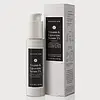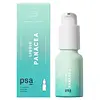What's inside
What's inside
 Key Ingredients
Key Ingredients

 Benefits
Benefits

 Concerns
Concerns

 Ingredients Side-by-side
Ingredients Side-by-side

Water
Skin ConditioningPropanediol
SolventPhospholipids
Skin ConditioningPhytonadione Epoxide
AstringentLinoleic Acid
CleansingDocosahexaenoic Acid
Skin ConditioningPinus Pinaster Bark Extract
AntioxidantEicosapentaenoic Acid
EmollientPhytosphingosine
Skin ConditioningCurcuma Longa Root Extract
MaskingPhosphatidylcholine
EmulsifyingNiacinamide
SmoothingLeuconostoc/Radish Root Ferment Filtrate
AntimicrobialPolyacrylate Crosspolymer-6
Emulsion StabilisingPhenylpropanol
MaskingLinolenic Acid
CleansingArnica Montana Flower Extract
MaskingCordyceps Sinensis Extract
AntioxidantTrametes Versicolor Extract
Caprylic/Capric Triglyceride
MaskingGlycerin
HumectantBisabolol
MaskingSorbitol
Humectant3-O-Ethyl Ascorbic Acid
Skin ConditioningSodium Hyaluronate
HumectantCaprylyl Glycol
EmollientPhenoxyethanol
PreservativeButylene Glycol
HumectantEthylhexylglycerin
Skin ConditioningT-Butyl Alcohol
PerfumingSodium Citrate
BufferingXanthan Gum
EmulsifyingTetrasodium Glutamate Diacetate
Tocopheryl Acetate
AntioxidantPotassium Sorbate
PreservativeSodium Benzoate
MaskingTocopherol
AntioxidantCitric Acid
BufferingWater, Propanediol, Phospholipids, Phytonadione Epoxide, Linoleic Acid, Docosahexaenoic Acid, Pinus Pinaster Bark Extract, Eicosapentaenoic Acid, Phytosphingosine, Curcuma Longa Root Extract, Phosphatidylcholine, Niacinamide, Leuconostoc/Radish Root Ferment Filtrate, Polyacrylate Crosspolymer-6, Phenylpropanol, Linolenic Acid, Arnica Montana Flower Extract, Cordyceps Sinensis Extract, Trametes Versicolor Extract, Caprylic/Capric Triglyceride, Glycerin, Bisabolol, Sorbitol, 3-O-Ethyl Ascorbic Acid, Sodium Hyaluronate, Caprylyl Glycol, Phenoxyethanol, Butylene Glycol, Ethylhexylglycerin, T-Butyl Alcohol, Sodium Citrate, Xanthan Gum, Tetrasodium Glutamate Diacetate, Tocopheryl Acetate, Potassium Sorbate, Sodium Benzoate, Tocopherol, Citric Acid
Water
Skin ConditioningGlycerin
HumectantPolyglyceryl-4 Laurate
EmulsifyingTocopheryl Acetate
AntioxidantSaccharomyces/Xylinum/Black Tea Ferment
Skin ConditioningCarthamus Tinctorius Seed Oil
MaskingLeuconostoc/Radish Root Ferment Filtrate
AntimicrobialCaprylyl Glycol
EmollientLauryl Laurate
Skin ConditioningCentella Asiatica Leaf Extract
Skin ConditioningCamellia Sinensis Leaf Extract
AntimicrobialCentella Asiatica Meristem Cell Culture
AntioxidantMadecassoside
AntioxidantBisabolol
MaskingSodium Hyaluronate
HumectantHyaluronic Acid
HumectantCandelilla/Jojoba/Rice Bran Polyglyceryl-3 Esters
EmulsifyingHydroxyethylcellulose
Emulsion StabilisingXanthan Gum
EmulsifyingGlyceryl Stearate
EmollientC12-15 Alkyl Benzoate
AntimicrobialSodium Gluconate
Skin ConditioningSodium Stearoyl Glutamate
CleansingPotassium Sorbate
PreservativeHydroxyethyl Acrylate/Sodium Acryloyldimethyl Taurate Copolymer
Emulsion StabilisingCetearyl Alcohol
EmollientCitric Acid
BufferingSodium Stearoyl Lactylate
EmulsifyingPhenoxyethanol
PreservativeWater, Glycerin, Polyglyceryl-4 Laurate, Tocopheryl Acetate, Saccharomyces/Xylinum/Black Tea Ferment, Carthamus Tinctorius Seed Oil, Leuconostoc/Radish Root Ferment Filtrate, Caprylyl Glycol, Lauryl Laurate, Centella Asiatica Leaf Extract, Camellia Sinensis Leaf Extract, Centella Asiatica Meristem Cell Culture, Madecassoside, Bisabolol, Sodium Hyaluronate, Hyaluronic Acid, Candelilla/Jojoba/Rice Bran Polyglyceryl-3 Esters, Hydroxyethylcellulose, Xanthan Gum, Glyceryl Stearate, C12-15 Alkyl Benzoate, Sodium Gluconate, Sodium Stearoyl Glutamate, Potassium Sorbate, Hydroxyethyl Acrylate/Sodium Acryloyldimethyl Taurate Copolymer, Cetearyl Alcohol, Citric Acid, Sodium Stearoyl Lactylate, Phenoxyethanol
 Reviews
Reviews

Ingredients Explained
These ingredients are found in both products.
Ingredients higher up in an ingredient list are typically present in a larger amount.
Bisabolol is famous for its skin soothing properties. It does this by blocking inflammatory signals, helping to reduce your body's reaction to irritation.
This ingredient also interferes with the process of hyperpigmentation. This can help with reducing dark spots and uneven tone.
Bisabolol is an antioxidant. Antioxidants help fight free-radicals. Free-radicals are molecules that may damage your skin cells. By fighting these free-radicals, Bisabolol may slow down signs of aging.
Studies have shown Bisabolol to have antimicrobial properties and may be a fungicide. These properties help preserve a product's shelf life.
All these properties makes bisabolol a great skin barrier helper ingredient.
Bisabolol also helps the absorption of other ingredients.
Note: Synthetic Bisabolol has been shown to be less effective.
Learn more about BisabololCaprylyl Glycol is a humectant and emollient, meaning it attracts and preserves moisture.
It is a common ingredient in many products, especially those designed to hydrate skin. The primary benefits are retaining moisture, skin softening, and promoting a healthy skin barrier.
Though Caprylyl Glycol is an alcohol derived from fatty acids, it is not the kind that can dry out skin.
This ingredient is also used as a preservative to extend the life of products. It has slight antimicrobial properties.
Learn more about Caprylyl GlycolCitric Acid is an alpha hydroxy acid (AHA) naturally found in citrus fruits like oranges, lemons, and limes.
Like other AHAs, citric acid can exfoliate skin by breaking down the bonds that hold dead skin cells together. This helps reveal smoother and brighter skin underneath.
However, this exfoliating effect only happens at high concentrations (20%) which can be hard to find in cosmetic products.
Due to this, citric acid is usually included in small amounts as a pH adjuster. This helps keep products slightly more acidic and compatible with skin's natural pH.
In skincare formulas, citric acid can:
While it can provide some skin benefits, research shows lactic acid and glycolic acid are generally more effective and less irritating exfoliants.
Most citric acid used in skincare today is made by fermenting sugars (usually from molasses). This synthetic version is identical to the natural citrus form but easier to stabilize and use in formulations.
Read more about some other popular AHA's here:
Learn more about Citric AcidGlycerin is already naturally found in your skin. It helps moisturize and protect your skin.
A study from 2016 found glycerin to be more effective as a humectant than AHAs and hyaluronic acid.
As a humectant, it helps the skin stay hydrated by pulling moisture to your skin. The low molecular weight of glycerin allows it to pull moisture into the deeper layers of your skin.
Hydrated skin improves your skin barrier; Your skin barrier helps protect against irritants and bacteria.
Glycerin has also been found to have antimicrobial and antiviral properties. Due to these properties, glycerin is often used in wound and burn treatments.
In cosmetics, glycerin is usually derived from plants such as soybean or palm. However, it can also be sourced from animals, such as tallow or animal fat.
This ingredient is organic, colorless, odorless, and non-toxic.
Glycerin is the name for this ingredient in American English. British English uses Glycerol/Glycerine.
Learn more about GlycerinLeuconostoc/Radish Root Ferment Filtrate is a natural preservative. It comes from fermenting radish roots with a bacteria called leuconostoc.
Leuconostoc comes from lactic acid.
This ingredient has antimicrobial properties and helps prevent the growth of bacteria in a product.
Leuconostoc is used to make the traditional Korean side-dish, kimchi. It is also used to make sourdough bread (both incredibly yummy foods).
Learn more about Leuconostoc/Radish Root Ferment FiltratePhenoxyethanol is a preservative that has germicide, antimicrobial, and aromatic properties. Studies show that phenoxyethanol can prevent microbial growth. By itself, it has a scent that is similar to that of a rose.
It's often used in formulations along with Caprylyl Glycol to preserve the shelf life of products.
Potassium Sorbate is a preservative used to prevent yeast and mold in products. It is commonly found in both cosmetic and food products.
This ingredient comes from potassium salt derived from sorbic acid. Sorbic acid is a natural antibiotic and effective against fungus.
Both potassium sorbate and sorbic acid can be found in baked goods, cheeses, dried meats, dried fruit, ice cream, pickles, wine, yogurt, and more.
You'll often find this ingredient used with other preservatives.
Learn more about Potassium SorbateSodium Hyaluronate is hyaluronic acid's salt form. It is commonly derived from the sodium salt of hyaluronic acid.
Like hyaluronic acid, it is great at holding water and acts as a humectant. This makes it a great skin hydrating ingredient.
Sodium Hyaluronate is naturally occurring in our bodies and is mostly found in eye fluid and joints.
These are some other common types of Hyaluronic Acid:
Learn more about Sodium HyaluronateTocopheryl Acetate is AKA Vitamin E. It is an antioxidant and protects your skin from free radicals. Free radicals damage the skin by breaking down collagen.
One study found using Tocopheryl Acetate with Vitamin C decreased the number of sunburned cells.
Tocopheryl Acetate is commonly found in both skincare and dietary supplements.
Learn more about Tocopheryl AcetateWater. It's the most common cosmetic ingredient of all. You'll usually see it at the top of ingredient lists, meaning that it makes up the largest part of the product.
So why is it so popular? Water most often acts as a solvent - this means that it helps dissolve other ingredients into the formulation.
You'll also recognize water as that liquid we all need to stay alive. If you see this, drink a glass of water. Stay hydrated!
Learn more about WaterXanthan gum is used as a stabilizer and thickener within cosmetic products. It helps give products a sticky, thick feeling - preventing them from being too runny.
On the technical side of things, xanthan gum is a polysaccharide - a combination consisting of multiple sugar molecules bonded together.
Xanthan gum is a pretty common and great ingredient. It is a natural, non-toxic, non-irritating ingredient that is also commonly used in food products.
Learn more about Xanthan Gum